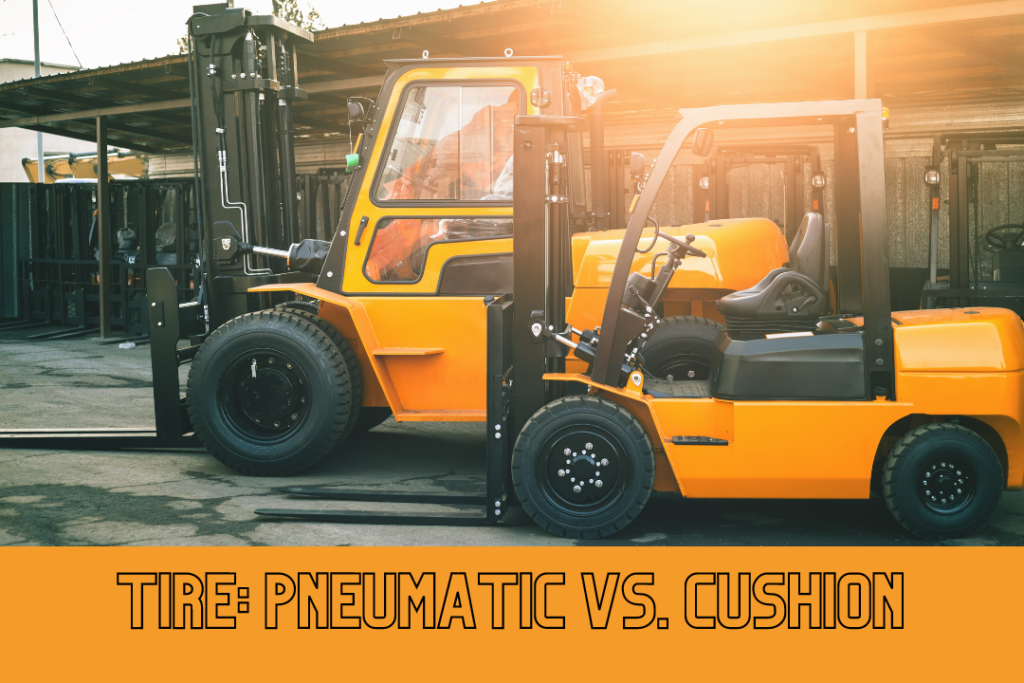Forklifts are essential in various work environments, each with its unique challenges. Choosing the right forklift tires is crucial, as different tire types can significantly impact performance and safety. This article explores the key differences between Cushion vs Pneumatic Forklift Tires, explaining their advantages, disadvantages, and best applications for each. Dive into the details to make an informed decision that best suits your operational needs.
Forklift Tires: A Crucial Decision
Before comparing tire types, it’s crucial to understand the key factors influencing the selection of the right tire for a forklift. These factors play a vital role in evaluating tire designs and making an informed decision based on the specific needs of the operation.
Factors Influencing Forklift Tire Selection
Terrain
The ground beneath a forklift greatly impacts its safety and stability. Different terrains necessitate specific tire designs to ensure traction and resist damage.
Ride Quality
Considering that operators spend long hours on forklifts, ride quality is paramount for comfort and performance. Tire selection directly influences the overall driving experience.
Maneuverability
Tire choice significantly affects a forklift’s ability to turn and maneuver, depending on load type, size, and weight. Factors like tire design, style, diameter, and width contribute to maneuverability.
Environment
The operating environment, whether wet and muddy outdoors or clean and dry indoors, requires tailored tire selections for optimal performance and reliability.
Load Capacity
Forklift tires serve as compressible surfaces transferring material weight to the ground. Overloading tires can lead to unsafe handling, instability, and accidents. Selecting tires supporting intended loads is critical.
Forklift Classification/Design
Forklifts are rated and designed for specific applications, environments, and duty cycles. Tire selection aligns with the overall rating, and converting from one tire type to another is often impractical.
Exploring Forklift Tire Types
Now, let’s compare the two most common forklift tire options available.
Learn More : Forklift Classes and Types
Pneumatic Tires: Where Comfort Meets Durability
When envisioning typical automobile tires, pneumatic tires come to mind. These rubber or synthetic material tires, with embedded traction treads and tall sidewalls, offer a comfortable ride. Pneumatic tires, filled with compressed air, excel in rough terrains and aggressive outdoor environments.
Air Pneumatic Tires
Designed for heavy-duty outdoor applications, these tires provide adaptable traction, shock absorption, and high ground clearance. However, they are prone to punctures, have a higher wear rate, and may deflate over time.
Solid Pneumatic Tires
Featuring a solid rubber design, these tires eliminate the risk of deflation and punctures. Ideal for consistent terrains in both indoor and outdoor settings, they prioritize durability over ride comfort.
Cushion Tires: Tailored for Indoors
Cushion Tires stand out as the go-to choice for indoor, clean environments where precision and efficiency are paramount. Unlike their robust pneumatic counterparts, Cushion Tires are specifically crafted to excel in scenarios characterized by smooth, tidy surfaces.
Construction and Composition
Cushion Tires are constructed with a unique design – solid rubber bands expertly molded onto steel bands. This composition creates a tire that is not only durable but also adept at handling the controlled conditions found indoors. The solid rubber construction eliminates the risk of punctures and provides a reliable, long-lasting solution for indoor applications.
Economic Benefits
One of the key advantages of Cushion Tires lies in their economic benefits. These tires are generally more budget-friendly, making them an attractive option for businesses looking to optimize costs without compromising on performance within their indoor spaces. The solid construction minimizes the need for frequent replacements, contributing to long-term financial savings.
Lower Weight Capacities
Cushion Tires are tailored for operations with lower weight capacities. While they may not be the choice for heavy-duty outdoor tasks, their specialized design makes them highly efficient for lighter loads commonly encountered in indoor settings. This targeted capacity aligns perfectly with the requirements of warehouses, distribution centers, and manufacturing floors.
Reduced Ride Quality: A Trade-off for Precision
In the pursuit of optimizing for indoor efficiency, Cushion Tires do come with a trade-off – reduced ride quality compared to pneumatic alternatives. However, this compromise is intentional, as the emphasis shifts from shock absorption to enhanced maneuverability and precise handling in confined spaces.
Tread Patterns for Versatility
Cushion Tires offer flexibility in tread patterns. For strictly indoor use on smooth, clean surfaces, a completely smooth design might be preferred. However, for scenarios where indoor/outdoor transitions occur or environments like frozen storage rooms are encountered, tread patterns can be incorporated for added traction without compromising on the tire’s overall efficiency.
Learn More : What are Forklift Carriages and Forks
Selection Criteria
To guide your tire selection, consider the following scenarios:
Air Pneumatic Tires: Heavy-duty outdoor use with uneven terrain.
Solid Pneumatic Tires: Heavy-duty indoor/outdoor use with consistent terrain.
Cushion Tires: Indoor or light outdoor applications with smooth, clean surfaces.
Discuss your specific needs with a forklift distributor and Environmental Health and Safety representative to ensure your tire selection aligns with handling requirements and site safety. The right tire choice enhances performance, safety, and efficiency in your material handling operations.



